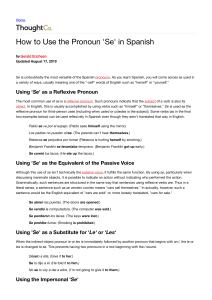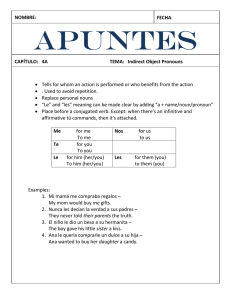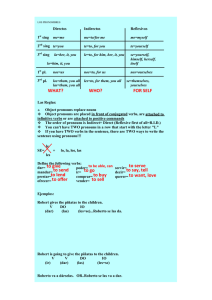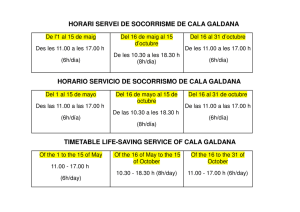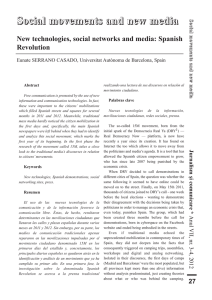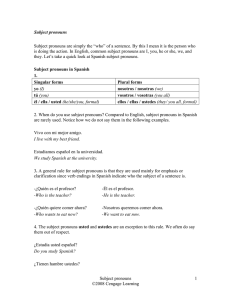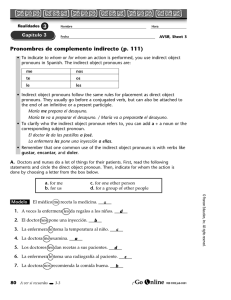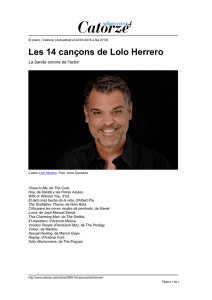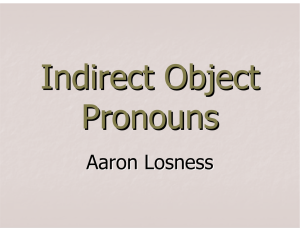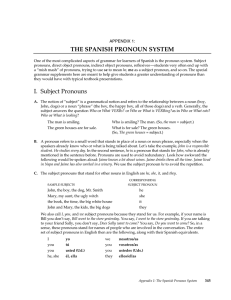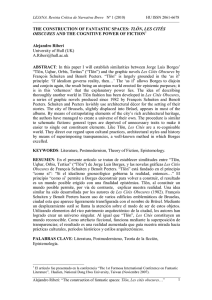Spanish: Problems with la, le, lo
Anuncio
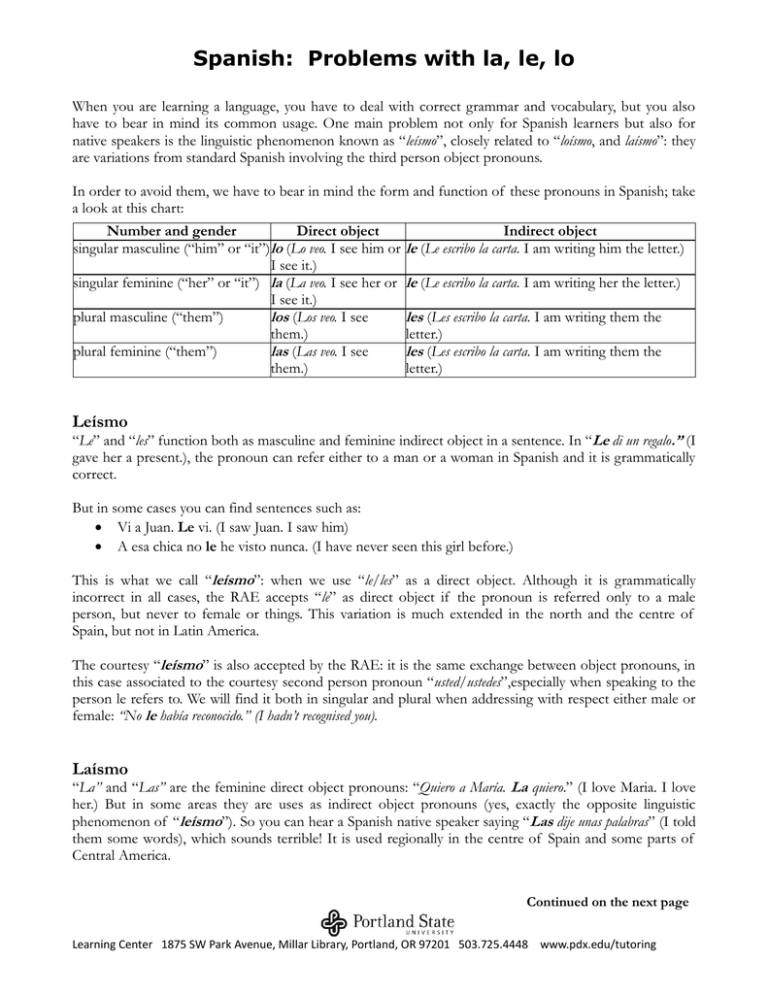
Spanish: Problems with la, le, lo When you are learning a language, you have to deal with correct grammar and vocabulary, but you also have to bear in mind its common usage. One main problem not only for Spanish learners but also for native speakers is the linguistic phenomenon known as “leísmo”, closely related to “loísmo, and laísmo”: they are variations from standard Spanish involving the third person object pronouns. In order to avoid them, we have to bear in mind the form and function of these pronouns in Spanish; take a look at this chart: Number and gender Direct object singular masculine (“him” or “it”) lo (Lo veo. I see him or I see it.) singular feminine (“her” or “it”) la (La veo. I see her or I see it.) plural masculine (“them”) los (Los veo. I see them.) plural feminine (“them”) las (Las veo. I see them.) Indirect object le (Le escribo la carta. I am writing him the letter.) le (Le escribo la carta. I am writing her the letter.) les (Les escribo la carta. I am writing them the letter.) les (Les escribo la carta. I am writing them the letter.) Leísmo “Le” and “les” function both as masculine and feminine indirect object in a sentence. In “Le di un regalo.” (I gave her a present.), the pronoun can refer either to a man or a woman in Spanish and it is grammatically correct. But in some cases you can find sentences such as: Vi a Juan. Le vi. (I saw Juan. I saw him) A esa chica no le he visto nunca. (I have never seen this girl before.) This is what we call “leísmo”: when we use “le/les” as a direct object. Although it is grammatically incorrect in all cases, the RAE accepts “le” as direct object if the pronoun is referred only to a male person, but never to female or things. This variation is much extended in the north and the centre of Spain, but not in Latin America. The courtesy “leísmo” is also accepted by the RAE: it is the same exchange between object pronouns, in this case associated to the courtesy second person pronoun “usted/ustedes”,especially when speaking to the person le refers to. We will find it both in singular and plural when addressing with respect either male or female: “No le había reconocido.” (I hadn’t recognised you). Laísmo “La” and “Las” are the feminine direct object pronouns: “Quiero a María. La quiero.” (I love Maria. I love her.) But in some areas they are uses as indirect object pronouns (yes, exactly the opposite linguistic phenomenon of “leísmo”). So you can hear a Spanish native speaker saying “Las dije unas palabras” (I told them some words), which sounds terrible! It is used regionally in the centre of Spain and some parts of Central America. Continued on the next page Learning Center 1875 SW Park Avenue, Millar Library, Portland, OR 97201 503.725.4448 www.pdx.edu/tutoring Spanish: Problems with la, le, lo Loísmo “Lo/los” are the masculine direct object pronouns, which can also be found being incorrectly used instead of “le/les”. A sentence such as “Lo di una bofetada” (I gave him a slap) is a good example of it. Both laísmo and loísmo are considered as vulgarisms. Don´t worry if you have problems deciding which pronoun to use, because this is a hard task even for native speakers. There are some problematic verbs you´ll have to ckeck to avoid these linguistic deviations: avisar, ayudar, curar, disparar, escribir, llamar, molestar, obedecer, pegar, saludar… and some more.. Práctica How about doing some practice now? Here you have some sentences to fill in with le, les, lo, los, la, las: 1. _____sugirieron algunos cambios a sus jefas. 2. A Laura ____he visto muy contenta. 3. No _____diremos nada a tus compañeras. 4. A mi hermana no _____gusta que _____trates así. 5. Compró el libro y _____ leyó en solo dos días. 6. No ____ han hecho ningún regalo. 7. A mis amigas ____ he dejado en la esquina. 8. A él no _____ han aceptado en la academia. 9. El examen _____ entregué enseguida. 10. A Javier _____ regalé un disco. 11. Preferí no contar____ toda la verdad. 12. ____ presté un lápiz y no me ____ ha devuelto. Prepared by Karlos Castillo for the Learning Center, spring 2013 Problems using la, le, lo (laísmo, leísmo, loísmo) Posted on 15. Sep, 2011 by Magda in Spanish Grammar Learning Center 1875 SW Park Avenue, Millar Library, Portland, OR 97201 503.725.4448 www.pdx.edu/tutoring
